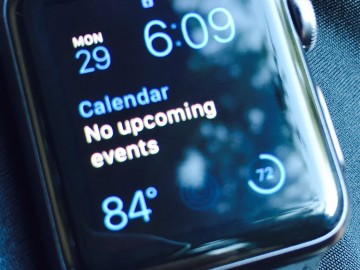Following the global success of Apple iPods, iPhones, and iPads, many have wondered whether the Apple Watch would enjoy the same level of success. As with many Apple products, the Apple Watch delivers an intuitive and accessible user experience through the use of cutting-edge technology. Essentially, the Apple Watch is a mini-computer on your wristband, with two hardware buttons and a compatible screen connected to an iPhone by Bluetooth. This means that the smartwatch is not a standalone device, and must be used in conjunction with an iPhone. While the Apple Watch is arguably the best smartwatch on the market, it is still a first-generation product. Consequently, in order to revolutionize the smartwatch industry, the Apple Watch requires many improvements, most of which are software-related. The Apple Watch is far too complex a product to review extensively in one article. As a result, I have decided to focus on the device’s most prevalent benefits and drawbacks. This critique will address two of the product’s most impressive features – its Force Touch and Taptic Engine; as well as its two most commonly cited drawbacks – its complexity and loading issues.
The Force Touch on the Apple Watch represents a breakthrough in smartwatch interfaces. The device has three inputs: the digital crown, the side button, also known as the power button, and the touchscreen. The digital crown is similar to a traditional crown, but reinvented to improve screen navigation. The Apple Watch’s touchscreen is unique, as it can differentiate between a gentle and a more forceful touch. This innovation is significant, as the force touch eliminates the need for multiple buttons, which would have complicated an already challenging user experience.
Another key feature of the Apple Watch is its Taptic Engine, which informs the user of a notification by sending out haptic feedback, in the form of a light tap on the wrist. The light tap seems perhaps too subtle at first; I barely noticed it the first few times. However, eventually, I recognized the ingenuity of this technology. The Taptic Engine is designed so that the user will gently be made aware of a notification, without drawing them away from their present task. This would be ideal for me when I am out with friends or working, as I would not feel compelled to check my iPhone when I receive a notification, unless I was expecting something important. Given society’s technology obsession, the Taptic Engine is a refreshing innovation, in that it will allow users to enjoy the present, without feeling obligated to constantly check their phones for incoming emails, texts and other notifications.
Though the general consensus is that the Apple Watch is a superior smartwatch, many have noted the need for significant improvements. Perhaps the most discussed drawback of the Apple Watch is that many of its third-party apps are poorly built, and not customized to the device. For example, the Twitter app does not allow the user to view comments on his or her tweets. Another common complaint involves the apps’ unusually slow loading times. Given that expectations dictate that technology should be almost immediately accessible, waiting up to 30 seconds for an app to load is perceived by many users to be disappointing and frustrating. Apple fans have acknowledged this issue, while asserting that the second-generation model will more than likely shorten these loading times, as more customized apps are designed for the device.
The second most common complaint about the Apple Watch is that it has a surplus of features. Most users, even those that consider themselves tech-savvy, need two to three days to become comfortable with the product. This is a much steeper learning curve than is expected of Apple products, which are renowned for their user-friendliness. Moreover, the functionality of the device’s two buttons – the digital crown and power button – is frequently counterintuitive. For example, pressing the digital crown is meant to return the user to the home screen. However, in my experience with the product, I was sometimes returned to the home screen, and other times, to the watch screen. Though these issues will likely be resolved in updates, I expect a company of Apple’s reputation to troubleshoot its products before releasing them.
From an innovation standpoint, the Apple Watch rivals other Apple products.. In particular, the Force Touch and the Taptic Engine demonstrate Apple’s ability to employ cutting-edge technology to provide an intuitive user experience. That being said, the Apple Watch is still a first-generation product that requires significant software improvements, if it is to compare with Apple’s most impressive devices. The long loading times for apps, as well as the lack of user-friendliness associated with the Apple brand, significantly detracts from the user experience. However, if you wish to remain up-to-date on the newest innovations of a rapidly changing industry, you should purchase the Apple Watch. This product marks the beginning of a smartwatch revolution. As Tim Cook, the CEO of Apple, said, “The Apple Watch is the first smartwatch that matters.”
*This gadget critique was done by Kibrom Berhane, Freshman at Everett Community College.





